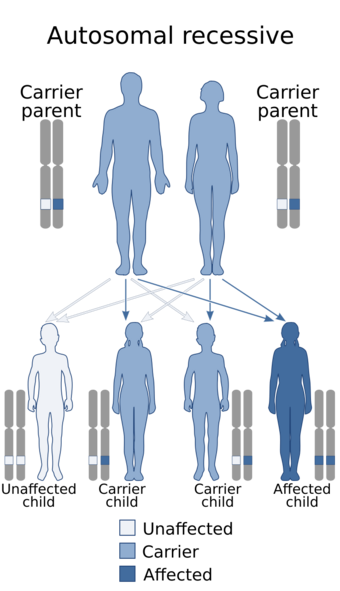Medicine:Odontoonychodermal dysplasia
| Odontoonychodermal dysplasia | |
|---|---|
 | |
| Specialty | Medical genetics |
| Prevention | none |
| Frequency | rare |
Odontoonychodermal dysplasia is a rare genetic disorder which is characterized by systemic abnormalities of the teeth, the nails of the fingers and toes, the skin, the hair cells, and the sweat glands. It is a type of syndromic ectodermal dysplasia.
Signs and symptoms
Individuals with this condition typically have the following symptoms: complete absence of both the deciduous and permanent teeth, cone-shaped canines and incisors, generalized dysplasia of the nails, palmoplantar hyperkeratosis, chronic skin dryness, and variable degrees of both hypotrichosis and either hyperhidrosis or hypohidrosis.[1][2]
Complications
The oligodontia associated with this condition results in both functional/mechanical and cosmetic problems.[3]
Hyperhidrosis can increase one's susceptibility to infections and might cause problems with oneself's self esteem.[4]
Hypohidrosis can result in a higher risk for suffering from heat-related illness, such as heat stroke.[5]
Genetics
This condition is caused by homozygous mutations of the WNT10A gene, located in the second chromosome. These mutations are inherited in an autosomal recessive manner, which means that for a child to be born with the condition, they must inherit two copies of a mutation from both parents.[6]
Diagnosis
This condition can be diagnosed through symptomatic examination and genetic testing.[7]
Treatment
Treatment is focused on the symptoms
Epidemiology
According to OMIM, around 30 cases from families in Lebanon, Germany , Turkey, and India have been described in medical literature.[8]
History
This condition was first discovered in 1983 by Fadhil et al. when they described 3 incestuous Muslim Shiite sibships from a family in Lebanon. Of the 24 children produced in these sibships, 7 were affected with what they (the researchers) a thought to be a novel ectodermal dysplasia syndrome, said children had nail dystrophy, peg-shaped incisors, erythematous facial lesions, hyperhidrotic palms and soles with thickened skin, dry sparse hair, and eyebrow thinning.[9]
In 2007, Adaimy et al. found the molecular cause for this condition in affected members of 3 consanguineous Muslim Shiite families in Lebanon: they found a homozygous mutation in the WNT10A gene that was shared by all of the affected family members, said mutation resulted in a short, prematurely terminated protein of 232 amino acids instead of the usual amount of 417. Of the three families, two had been previously described in medical literature.[10]
See also
- Anonychia
- Congenital onychodysplasia of the index fingers
References
- ↑ "Odontoonychodermal dysplasia - About the Disease - Genetic and Rare Diseases Information Center" (in en). https://rarediseases.info.nih.gov/diseases/4054/odontoonychodermal-dysplasia.
- ↑ RESERVED, INSERM US14-- ALL RIGHTS. "Orphanet: Odonto onycho dermal dysplasia" (in en). https://www.orpha.net/consor/cgi-bin/OC_Exp.php?lng=en&Expert=2721.
- ↑ Nubulus, Erik (2022-05-31). "What are the consequences of missing teeth for your health?" (in en-US). https://clinicadrvilar.com/en/what-the-consequences-have-the-lack-of-dental-pieces-for-your-health/.
- ↑ "Hyperhidrosis - Symptoms and causes" (in en). https://www.mayoclinic.org/diseases-conditions/hyperhidrosis/symptoms-causes/syc-20367152.
- ↑ "What Is Hypohidrosis?" (in en). https://www.webmd.com/skin-problems-and-treatments/what-is-hypohidrosis.
- ↑ "Entry - *606268 - WINGLESS-TYPE MMTV INTEGRATION SITE FAMILY, MEMBER 10A; WNT10A - OMIM" (in en-us). https://omim.org/entry/606268#0001.
- ↑ "odontoonychodermal dysplasia Archives - NFED". 6 December 2017. https://www.nfed.org/tag/odontoonychodermal-dysplasia/.
- ↑ "Entry - #257980 - ODONTOONYCHODERMAL DYSPLASIA; OODD - OMIM" (in en-us). https://omim.org/entry/257980#3.
- ↑ Fadhil, M.; Ghabra, T. A.; Deeb, M.; Der Kaloustian, V. M. (February 1983). "Odontoonychodermal dysplasia: a previously apparently undescribed ectodermal dysplasia". American Journal of Medical Genetics 14 (2): 335–346. doi:10.1002/ajmg.1320140213. ISSN 0148-7299. PMID 6837628. https://pubmed.ncbi.nlm.nih.gov/6837628/.
- ↑ Adaimy, Lynn; Chouery, Eliane; Megarbane, Hala; Mroueh, Salman; Delague, Valerie; Nicolas, Elsa; Belguith, Hanen; de Mazancourt, Philippe et al. (October 2007). "Mutation in WNT10A is associated with an autosomal recessive ectodermal dysplasia: the odonto-onycho-dermal dysplasia". American Journal of Human Genetics 81 (4): 821–828. doi:10.1086/520064. ISSN 0002-9297. PMID 17847007.
 |

